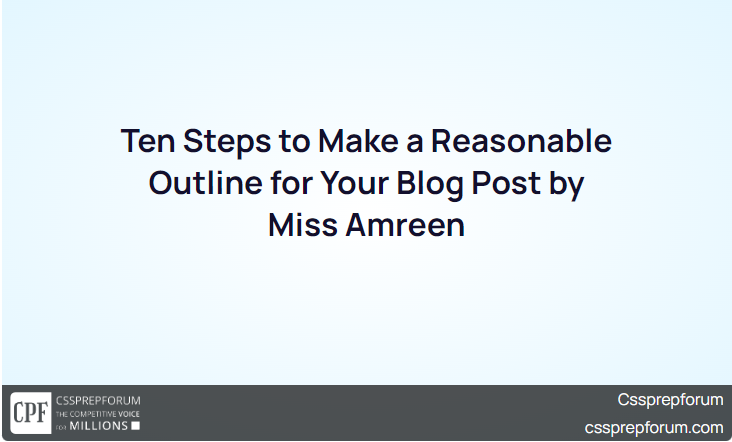Newcomers to blogging and seasoned writers share one trait, the constant desire to organize our thoughts. It needs more than a stream of vision to place sentences on the keyboard to write a blog post. As it was in high school composition classes, the outline is the secret to a decent blog post. Writing a solid overview for your post would make it much easier to structure your thoughts logically, determine which parts are relevant and which aren’t, and stick to your word count targets without over-fluffing specific sections.
If you’re unsure if you can use an outline or the point, here are some of the advantages I’ve found when writing them.

First and foremost, you gain memory advantages. I am in the habit of coming up with ideas for sub-topics or observations to make in a blog article but then forgetting to use them before writing the post. By creating a map, I can include specific points roughly the same way they will appear in the post, ensuring that they are protected. It allows me to make my content more information-dense and valuable in general.

Second, it enables you to build a clear path from point A to point B to point C. You may have an idea of your presentation and what point you want to draw at the end of the article, but you get lost along the way. It’s all too tempting to try to go from point A to point B to point C, only to discover that you forgot to include point B in your message. When people read the hop from A to C, they may think it’s not helpful because it’s a conceptual leap with little help.
Outlines for blogging vary slightly from procedures for writing an academic paper or something similar. You’re not as limited, and it’s more of a guide to help you coordinate your thoughts than an assignment on which you’ll be assessed.
I’m going to write down a procedure here, but it’s not the procedure I use.
Set foundation for your blog idea
Lay the foundation for a strong message. The first thing you can do is set yourself up for good, which isn’t always part of the outlining technique. Here’s where your keyword testing, subject brainstorming, and reader profile analysis certainly be helpful. You can create a blog outline for any subject, but how do you know if it’s worth writing about? You must prepare the framework.
Step 1: Find out what’s already available. Some view this part of the foundation, but I use it to make my outline. About any subject you might ever like to talk about has already been covered by other blogs, possibly even your peers. It will spark ideas and provide additional data points, all of which are beneficial to the outlining process.
Step 2: Determine what your main points will be. I usually have an extensive list of the key topics I want to explore when they come to me. The next step is to organize them, so don’t get too uptight about it just yet. Have it on the website to see everything, read it, and use it as guidance for the upcoming section.
Step 3: Organize the arguments in a cohesive manner. Begin organizing your extensive list of points and pieces of information until you have it. It’s not uncommon for some of your issues to become sub-points for other points after your initial brainstorming. You’ll have a partial overview of some key topics, sub-topics, space for another main topic or two.
Step 4: Dissect each point into the most important facts, findings, or conclusions. Any subheading can cover some topics. A bulleted list, for example, maybe a good match for larger or more complicated subheads. I sometimes like to have a subject or two that I don’t intend to discuss but might serve as an excellent internal connection.
Step 5: Determine what data is required to validate your claims and use it where necessary. This is when you start filling in the vital information in your outlines. If you’re going to draw an inference, make sure steps are leading up to that. If you’re going to claim something as a fact, make sure you have evidence to back it up. In general, you want your post to be as well-supported as possible. In general, whether it’s first-hand data, insights, maps/diagrams, or case studies you relate to, you want to make your article as well-supported as possible.
Step 6: Balance all the segments. Determine if this isn’t necessary and can be cut, or whether it is essential and must be extended. Often, no matter how hard you try, an argument you want to make won’t suit you. You should push that aside and write another blog post about it later if it’s a conclusion you want to write about. If it’s just a vaguely related inference, cut it; it’ll be perfect.

Step 7: Reorder the points according to your extended description for a logical progression. You will also evaluate your outline to see if you like it or if it still needs improvement. If it’s not exactly where you want it, go back to phase three and repeat the process.
Step 8: Jot down your first draft. Start writing your drafts after you’ve completed the process and are pleased with your outline. Expand on each of the points you’ve written down. You’ll be able to transform your description into a blog post in no time if you build up each end into a paragraph or two.
Step 9: Revise, edit, improve your script. Some people compose an excellent first draft that only requires minor revisions to make them worth publishing. Others would need two to three rounds of revisions to have their draft in tip-top form. Once you’ve extended your description into a script, now is the time to do so.
Step 10: Make a title for your post. I agree with certain people who have their processes that you should come up with your title first. Your overall topic could have changed at this stage, and a new title would be advantageous. Also, you can try to improve your tags as much as possible.
If you want to meet your target audience’s demands, your blog posts should be rational and coherent. An outline for a blog post will help you stop rambling or disjointed prose and structure your ideas to make it easier for readers to absorb. These ten steps will enable you to outline any topic you wish to write upon.

About Miss Amreen Mir
Amreen Mir is a creative content writer who wants to bring change in society, working for youth development and women empowerment through her writings. At Howfiv, she aims to empower pen of various authors who want to voice up their thoughts through words and their writings. She has been into content writing for a long time and has been helping numerous aspiring writers align their thoughts in a rational and coherent manner.
CSS 2022 Solved Pakistan Affairs Past Papers
The following are the CSS 2022 Pakistan Affairs solved past papers questions. These questions have been evaluated and checked by Pakistan’s top Pakistan Affairs and Current Affairs coaches, who are either lecturers or officers and scored the highest marks in this paper. They include Miss Saba Baloch (CSS-2021), Miss Aimeen Mirza (CSS 2018), Miss Nirmal Hasni (DD NAB), Sir Rameez Ch. (Lecturer & Deputy Director), and Miss Zaineb Azam (the highest scorer – 76). Moreover, these questions have been attempted on the same pattern taught by Sir Syed Kazim Ali to his students who have been scoring the highest marks for years.
CSS 2021 Solved Pakistan Affairs Questions

More Essays
- Meaning Purposive Education
- Bureaucracy Doldrums
- Is Gender Equality a Myth?
- Pros and Cons of Globalization for Pakistan
- Islamophobia: Causes and Consequences
- Artificial intelligence: Its Merits and Demerits
- IMF Bailouts: Roads to Stability or Recipes for Disaster
- Can Foreign Aid Help A Country Achieve Economic Stability?
- Consequences of American Withdrawal from Afghanistan on South Asia
- Money And Success Do Not Change People; They Merely Amplify What Is Already There
- Almost Always, The Creative, Dedicated Minority Has Made The World Better












